
The Benedictines, officially the Order of Saint Benedict, are a mainly contemplative monastic order of the Catholic Church for men and for women who follow the Rule of Saint Benedict. Initiated in 529 they are the oldest of all the religious orders in the Latin Church. The male religious are also sometimes called the Black Monks, especially in English speaking countries, after the colour of their habits. Not all Benedictines wear black, however, with some like the Olivetans wearing white. They were founded by Benedict of Nursia, a 6th-century Italian monk who laid the foundations of Benedictine monasticism through the formulation of his Rule. Benedict's sister, Scholastica, possibly his twin, also became a religious from an early age, but chose to live as a hermit. They retained a close relationship until her death.
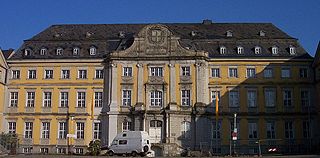
Werden Abbey was a Benedictine monastery in Essen-Werden (Germany), situated on the Ruhr.

Maria Laach Abbey is a Benedictine abbey situated in Glees, on the southwestern shore of the Laacher See, in the Eifel region of the Rhineland-Palatinate in Germany. It is a member of the Beuronese Congregation within the Benedictine Confederation. The abbey was built in the 11th-12th centuries and was originally known as "Abtei Laach" until 1862 when the Jesuits added the name "Maria".
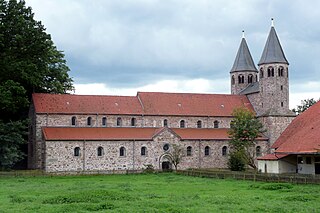
Bursfelde Abbey is a former Benedictine monastery located in Bursfelde, a hamlet which for administrative purposes is included in the municipality of nearby Hannoversch Münden in Lower Saxony, Germany. Today the abbey church and its estate cover a site of approximately 300 hectares which is administered by the Klosterkammer Hannover, a body that operates under the auspices of the Lower Saxony Ministry for Arts and the Sciences to look after reassigned or disused ecclesiastical buildings and other heritage properties in the region. The legal owner of the Bursfelde Monastery Complex is the Evangelical-Lutheran Church of Hanover.

Huysburg is a Benedictine monastery situated on the Huy hill range near Halberstadt, in the German state of Saxony-Anhalt. The Romanesque abbey has existed since about 1080 and was secularised in 1804. A new Benedictine community was founded in 1972 and has been headed by a prior since 1984.
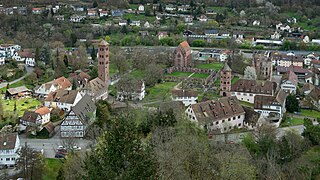
Hirsau Abbey, formerly known as Hirschau Abbey, was once one of the most important Benedictine abbeys of Germany. It is located in the Hirsau borough of Calw on the northern slopes of the Black Forest mountain range, in the present-day state of Baden-Württemberg. In the 11th and 12th century, the monastery was a centre of the Cluniac Reforms, implemented as "Hirsau Reforms" in the German lands by William of Hirsau. The complex was devastated during the War of the Palatine Succession in 1692 and not rebuilt. The ruins served as a quarry for a period of time.

Tegernsee Abbey is a former Benedictine monastery in the town and district of Tegernsee in Bavaria. Both the abbey and the town that grew up around it are named after the Tegernsee, the lake on the shores of which they are located. The name is from the Old High German tegarin seo, meaning great lake.

Muri Abbey was a Benedictine monastery dedicated to Saint Martin of Tours. It flourished for over eight centuries at Muri, in the Canton of Aargau, near Zürich, Switzerland. While the monastery is currently established as Muri-Gries in South Tyrol, the former abbey is now a museum and heritage site of national significance.

Affligem Abbey is a Benedictine abbey in the historic village of Hekelgem, now in the municipality of Affligem, Flemish Brabant, Belgium, 19 km (12 mi) to the north-west of Brussels. Dedicated in 1086, it was the most important monastery in the Duchy of Brabant and therefore often called Primaria Brabantiae.

Marienberg Abbey is a Benedictine abbey in Mals, Vinschgau in South Tyrol, northern Italy. It was founded in 1149 or 1150 by Ulrich von Tarasp and other nobles.
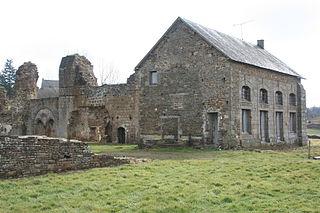
The monastic Congregation of Savigny started in the abbey of Savigny, situated in northern France, on the confines of Normandy and Brittany, in the Diocese of Coutances. It originated in 1105 when Vitalis of Mortain established a hermitage in the forest at Savigny in France.

The Vallombrosians are a monastic religious order in the Catholic Church. They are named after the location of their motherhouse founded in Vallombrosa, situated 30 km from Florence on the northwest slope of Monte Secchieta in the Pratomagno chain. They use the postnominal abbreviation OSBVall to distinguish themselves from other Benedictines, who generally use the abbreviation OSB.
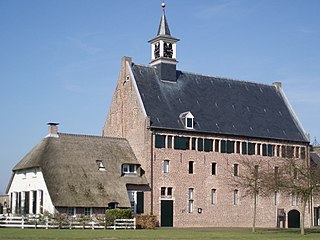
The Congregation of Windesheim is a congregation of Augustinian canons regular. It takes its name from its most important monastery, which was located at Windesheim, about four miles south of Zwolle on the IJssel, in the Netherlands.

Lobbes Abbey was a Benedictine monastery in the municipality of Lobbes, Hainaut, Belgium. The abbey played an important role in the religious, political and religious life of the Prince-Bishopric of Liège, especially around the year 1000. The abbey's founding saint is Saint Landelin; four other saints are also connected with the abbey.

Lamspringe Abbey is a former religious house of the English Benedictines in exile, at Lamspringe near Hildesheim in Germany.

Benno Gut was a Benedictine monk of the Archabbey of Maria Einsiedeln, Switzerland, and a cardinal of the Roman Catholic Church. He served as prefect of the Congregation for Divine Worship in the Roman Curia from 1969 until his death, and was elevated to the cardinalate in 1967.
St. Stephen's Abbey in Würzburg, Germany, was a Benedictine monastery, founded c.1013. It existed until 1803.

St. Matthias' Abbey is a Benedictine monastery in Trier, Rhineland-Palatinate, Germany.
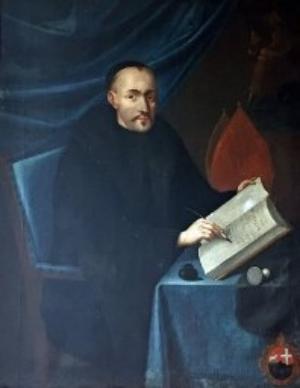
Clement Reyner D.D. (1589–1651) was an English Benedictine monk, who became abbot of Lamspringe in Germany.
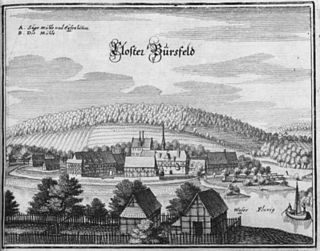
Johannes de Indagine, born Johannes von Hagen was a Benedictine monk and a notable abbot of Bursfelde Abbey. He was the originator of the Bursfelde Congregation.



















